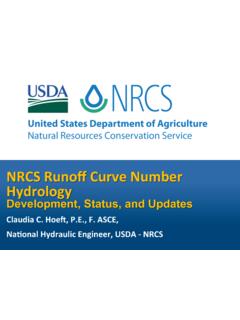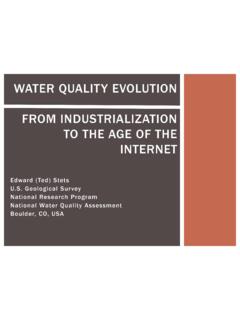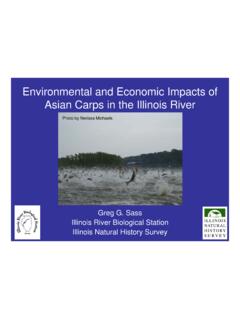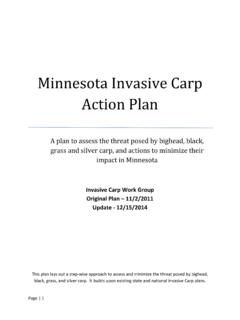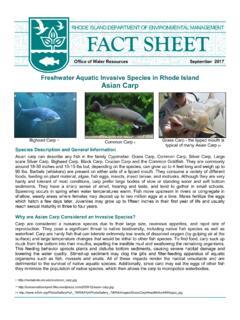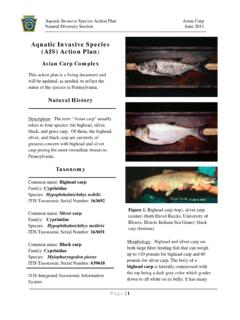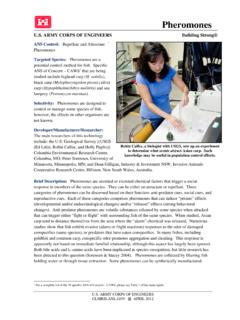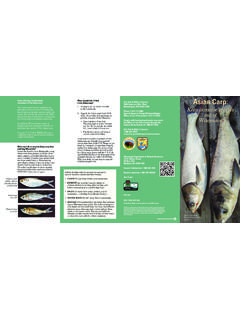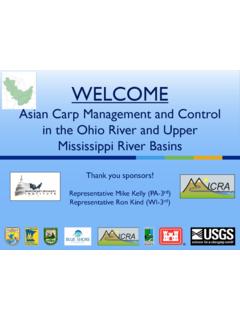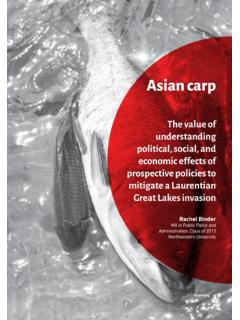Transcription of The Chicago Area Waterway System, Asian Carp, and the ...
1 The Chicago area Waterway system , Asian Carp, and the Great Lakes by Jim Duncker USGS-Illinois Water Science Center History and physical setting of the Waterway Lake Michigan Diversion Accounting USGS monitoring and Waterway hydraulics Aquatic invasive species and Asian Carp Waterway Separation Chicago River 2011 courtesy Chicago History Museum Chicago River 1800 Bubbly Creek, man standing on crusted sewage. Photo from Chicago History Museum. From 1850-1900, Chicago s population grew at a rate that exceeded the city sewage system , resulting in unsanitary conditions throughout the city Ye a r Population 1833 - 350 1850 - 29,963 1860 - 112,172 1870 - 298,977 1880 - 503,185 1890 - 1,099,850 1900 - 1,698,575 Illinois and Michigan Canal-1848 Built for navigation.
2 Mule-drawn barges Opened before railroads. 60 feet wide. 6 feet deep Not enough conveyance for Chicago sewage problems. 1848 - completion of the Illinois and Michigan Canal 1900 - completion of the Chicago Sanitary and Ship Canal 1910 - completion of the North Shore Channel 1922 - completion of the Cal-Sag Channel CAWS construction-historical timeline Chicago area Waterway system -a modern engineered Waterway A clean reliable municipal water supply. Transport of bulk goods in/out of the region. Flood-control for the Chicago metropolitan area .
3 A modern wastewater system serving million people. A recreational Waterway . Lake Michigan Diversion Withdrawing water from Lake Michigan and discharging that water to the Illinois/Mississippi River system via the CAWS Engineering marvel at it s time of construction. Largest public works excavation project ever undertaken up to its time. Resolved Chicago s long-standing sewage problems, providing for a clean municipal water supply, spurring economic growth and development Contested by other Great Lakes states, all the way to Supreme Court.
4 Led to the development of water use legislation throughout the Great Lakes region. Lake Michigan Diversion Accounting Diversion challenged in court by other Great Lakes states. Supreme Court decree limits the State of Illinois to 3,200 cfs mean annual flow Corps of Engineers responsible for accounting USGS technical expertise for flow monitoring Diversion Components -2007 Pumpage-municipal water supply Runoff-storm water runoff in the Chicago area that would have drained back to Lake Michigan. Direct diversions-Lake Michigan water that enters the CAWS through lakefront control structures.
5 The bulk of the direct diversions occur April-November to maintain navigable depths and water quality standards. Total diversion = 3,094 cfs USGS monitoring of the Chicago area Waterway 1984 - USGS established acoustic velocity meter streamgaging station at Romeoville for Lake Michigan diversion accounting. 1996 - USGS established lakefront acoustic velocity meter streamgaging stations at Columbus Drive, O Brien Lock and Dam, and Wilmette. 2003 - USGS asked to relocate Romeoville gage due to construction of Corps Fish Barrier II. 2005 - USGS establishes acoustic velocity meter streamgaging station near Lemont as a replacement for the Romeoville streamgaging station.
6 2009 - USGS participation in Asian carp rapid response efforts. 2010 USGS support of Waterway separation studies. 2011 USGS CAWS network evaluation in support of Great Lakes environmental restoration. Controlling Works: - Chicago River CW -Wilmette CW - O Brien L and D -Lockport CW Lockport Powerhouse Wastewater treatment plants: -North Side -Stickney -Calumet Thermal loads Chicago area Waterway A very complex hydraulic system Aquatic invasive species Courtesy of the USACE_Chicago District CSSC-Electric Fish Barrier 2002 Four species commonly referred to as Asian carps -grass carp (1963) -black carp (1970 s) -silver and bighead carp(1970) Introduced into US for aquaculture and biological control of plankton All have escaped confinement.
7 Migration through the Mississippi, and Illinois River system has been well-documented. Potential impact on the Great Lakes is unknown. Threaten a $ 7 Billion sport fishery. Asian carp Motivation Bighead Silver Asian carp-biology Native to fresh waters of eastern Asia. Four species-grass, black, bighead, and silver commonly referred to as Asian carps . Asian carp biology not fully understood. Silver and bighead carp are filter feeders. Compete with native fish for food. Prolific breeders Spawn in turbulent water on the rising limb of hydrograph.
8 Eggs and young larvae are buoyant. Eggs require X miles of free-flowing channel for larvae development Asian carp: Unknowns Are the Great Lakes too cold for Asian carp? Are the Great Lakes suitable habitat for Asian carp? Is there an adequate food supply (phytoplankton)in the Great Lakes ? Are Great Lakes tributaries spawning habitat ? where: C = consumption R = respiration A = active metabolism S = specific dynamic action F = egestion U = excretion B = biomass G = gonads/reproduction Asian Carp migration status Silver carp Bighead carp eDNA eDNA results are posted weekly to: Silver carp DNA bands in gel electrophoresis (UND photo) Used as an early indicator of possible carp presence.
9 Since 2009 very low numbers of (+) eDNA results from above the barrier in the CAWS. Many uncertainties about what a (+)eDNA result indicates 2 Asian carp caught in/near the CAWS. Asian Carp/eDNA issues Complex CAWS hydraulic setting complicates eDNA analysis. Unknown viability of Asian carp eDNA. Asian carp are able to avoid nets, electro-fishing and other traditional means of sampling, especially in deep water channels of CAWS. Spillover from the Des Plaines River into the Chicago and Sanitary and Ship Canal provides a Waterway connection that bypasses the Corps Fish Barrier.
10 Thresholds for Asian carp (AC) response actions with conventional gears and rotenone. (from Asian Carp Monitoring and Rapid Response Plan-May 2011) Asian carp rapid response protocol: - increased sampling - poisonings sampling of the CAWS with traditional gear, eDNA sampling and rapid response Photo Courtesy of the Chicago Tribune Asian Carp-Commercial harvest Governor Quinn Announces New Initiative to Control Asian Carp Population Agreement will Boost Commercial Fishing Industry, Creates 180 Jobs Chicago July 13, 2010. Governor Pat Quinn today announced a new initiative to stop the spread of invasive Asian carp species into the Great Lakes.

